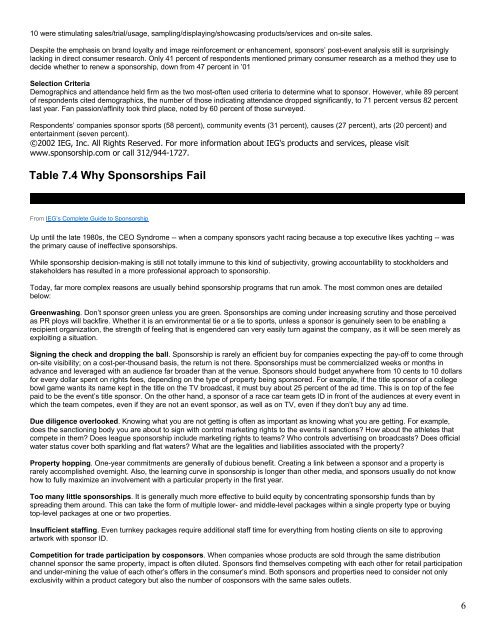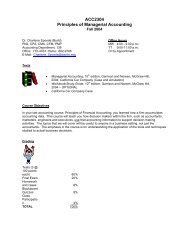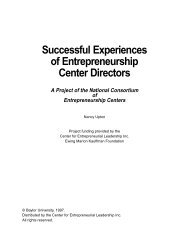1 Chapter 7 Set Sponsorship and Sales Promotion Objectives The ...
1 Chapter 7 Set Sponsorship and Sales Promotion Objectives The ...
1 Chapter 7 Set Sponsorship and Sales Promotion Objectives The ...
Create successful ePaper yourself
Turn your PDF publications into a flip-book with our unique Google optimized e-Paper software.
10 were stimulating sales/trial/usage, sampling/displaying/showcasing products/services <strong>and</strong> on-site sales.<br />
Despite the emphasis on br<strong>and</strong> loyalty <strong>and</strong> image reinforcement or enhancement, sponsors’ post-event analysis still is surprisingly<br />
lacking in direct consumer research. Only 41 percent of respondents mentioned primary consumer research as a method they use to<br />
decide whether to renew a sponsorship, down from 47 percent in ’01<br />
Selection Criteria<br />
Demographics <strong>and</strong> attendance held firm as the two most-often used criteria to determine what to sponsor. However, while 89 percent<br />
of respondents cited demographics, the number of those indicating attendance dropped significantly, to 71 percent versus 82 percent<br />
last year. Fan passion/affinity took third place, noted by 60 percent of those surveyed.<br />
Respondents’ companies sponsor sports (58 percent), community events (31 percent), causes (27 percent), arts (20 percent) <strong>and</strong><br />
entertainment (seven percent).<br />
©2002 IEG, Inc. All Rights Reserved. For more information about IEG's products <strong>and</strong> services, please visit<br />
www.sponsorship.com or call 312/944-1727.<br />
Table 7.4 Why <strong>Sponsorship</strong>s Fail<br />
From IEG’s Complete Guide to <strong>Sponsorship</strong><br />
Up until the late 1980s, the CEO Syndrome -- when a company sponsors yacht racing because a top executive likes yachting -- was<br />
the primary cause of ineffective sponsorships.<br />
While sponsorship decision-making is still not totally immune to this kind of subjectivity, growing accountability to stockholders <strong>and</strong><br />
stakeholders has resulted in a more professional approach to sponsorship.<br />
Today, far more complex reasons are usually behind sponsorship programs that run amok. <strong>The</strong> most common ones are detailed<br />
below:<br />
Greenwashing. Don’t sponsor green unless you are green. <strong>Sponsorship</strong>s are coming under increasing scrutiny <strong>and</strong> those perceived<br />
as PR ploys will backfire. Whether it is an environmental tie or a tie to sports, unless a sponsor is genuinely seen to be enabling a<br />
recipient organization, the strength of feeling that is engendered can very easily turn against the company, as it will be seen merely as<br />
exploiting a situation.<br />
Signing the check <strong>and</strong> dropping the ball. <strong>Sponsorship</strong> is rarely an efficient buy for companies expecting the pay-off to come through<br />
on-site visibility; on a cost-per-thous<strong>and</strong> basis, the return is not there. <strong>Sponsorship</strong>s must be commercialized weeks or months in<br />
advance <strong>and</strong> leveraged with an audience far broader than at the venue. Sponsors should budget anywhere from 10 cents to 10 dollars<br />
for every dollar spent on rights fees, depending on the type of property being sponsored. For example, if the title sponsor of a college<br />
bowl game wants its name kept in the title on the TV broadcast, it must buy about 25 percent of the ad time. This is on top of the fee<br />
paid to be the event’s title sponsor. On the other h<strong>and</strong>, a sponsor of a race car team gets ID in front of the audiences at every event in<br />
which the team competes, even if they are not an event sponsor, as well as on TV, even if they don’t buy any ad time.<br />
Due diligence overlooked. Knowing what you are not getting is often as important as knowing what you are getting. For example,<br />
does the sanctioning body you are about to sign with control marketing rights to the events it sanctions? How about the athletes that<br />
compete in them? Does league sponsorship include marketing rights to teams? Who controls advertising on broadcasts? Does official<br />
water status cover both sparkling <strong>and</strong> flat waters? What are the legalities <strong>and</strong> liabilities associated with the property?<br />
Property hopping. One-year commitments are generally of dubious benefit. Creating a link between a sponsor <strong>and</strong> a property is<br />
rarely accomplished overnight. Also, the learning curve in sponsorship is longer than other media, <strong>and</strong> sponsors usually do not know<br />
how to fully maximize an involvement with a particular property in the first year.<br />
Too many little sponsorships. It is generally much more effective to build equity by concentrating sponsorship funds than by<br />
spreading them around. This can take the form of multiple lower- <strong>and</strong> middle-level packages within a single property type or buying<br />
top-level packages at one or two properties.<br />
Insufficient staffing. Even turnkey packages require additional staff time for everything from hosting clients on site to approving<br />
artwork with sponsor ID.<br />
Competition for trade participation by cosponsors. When companies whose products are sold through the same distribution<br />
channel sponsor the same property, impact is often diluted. Sponsors find themselves competing with each other for retail participation<br />
<strong>and</strong> under-mining the value of each other’s offers in the consumer’s mind. Both sponsors <strong>and</strong> properties need to consider not only<br />
exclusivity within a product category but also the number of cosponsors with the same sales outlets.<br />
6

















